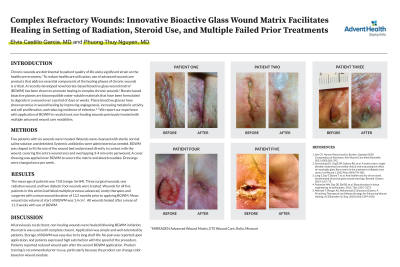Case Series/Study
(CS-039) Complex Refractory Wounds: Innovative Bioactive Glass Wound Matrix Facilitates Healing in Setting of Radiation, Steroid Use and Failed Prior Treatments

Chronic wounds are detrimental to patient quality of life and a significant strain on the healthcare economy. Use of advanced wound care products that address essential components of chronic wound healing phases is critical. A novel borate-based bioactive glass wound matrix* (BGWM) has been shown to promote healing in complex chronic wounds. Borate-based bioactive glasses are biocompatible water-soluble materials, formulated to degrade in a wound over a period of days or weeks. These absorbable bioactive glasses have shown promise in wound healing by improving angiogenesis, increasing metabolic activity and cell proliferation, and reducing incidence of infection. We report our experience with BGWM in recalcitrant, non-healing wounds previously treated with multiple advanced wound care modalities.
Methods:
Five patients with six wounds were treated. Wounds were cleansed with sterile normal saline solution and debrided. Systemic antibiotics were administered as needed. BGWM was shaped to fit the size of the wound bed and pressed directly in contact with the wound, covering the entire wound area and overlapping 3-4 mm onto periwound. A cover dressing was applied over BGWM to secure the matrix and absorb exudate. Dressings were changed once per week.
Results:
The mean age of patients was 73.8 (range: 56-84). Three surgical wounds, one radiation wound, and two diabetic foot wounds were treated. Wounds for all five patients in this series had failed multiple previous advanced, costly therapies and surgeries with a mean wound duration of 13.2 months prior to applying BGWM. Mean wound size volume at start of BGWM was 1.4 cm3. All wounds healed after a mean of 11.3 weeks with use of BGWM.
Discussion:
All previously recalcitrant, non-healing wounds were healed following BGWM initiation; the matrix was used until complete closure. Application was simple and well-tolerated by patients. Storage of BGWM was easy due to its long shelf life. No pain was reported upon application, and patients expressed high satisfaction with the speed of the procedure. Patients reported reduced wound pain after the second BGWM application. Product training is recommended prior to use, particularly because the product can change color based on wound exudate.
Trademarked Items: *MIRRAGEN Bioactive Glass Wound Matrix, ETS Wound Care, Rolla, MO
References: 1. Sen CK. Human Wound and Its Burden: Updated 2020 Compendium of Estimates. Adv Wound Care (New Rochelle). 2021;10(5):281-292.
2. Armstrong DG, Orgill DP, Galiano RD, et al. A multi-centre, single-blinded randomised controlled clinical trial evaluating the effect of resorbable glass fibre matrix in the treatment of diabetic foot ulcers. Int Wound J. 2022 May;19(4):791-801.
3. Jung S, Day T, Boone T, et al. Anti-biofilm activity of two novel, borate based, bioactive glass wound dressings. Biomed. Glasses 2019; 5:67–75.
4. Rahaman MN, Day DE, Bal BS, et al. Bioactive glass in tissue engineering. Acta Biomater. 2011; 7(6): 2355–2373.
5. Mehrabi T, Mesgar AS, Mohammadi Z. Bioactive Glasses: A Promising Therapeutic Ion Release Strategy for Enhancing Wound Healing. ACS Biomater Sci Eng. 2020;6(10):5399-5430.

.png)